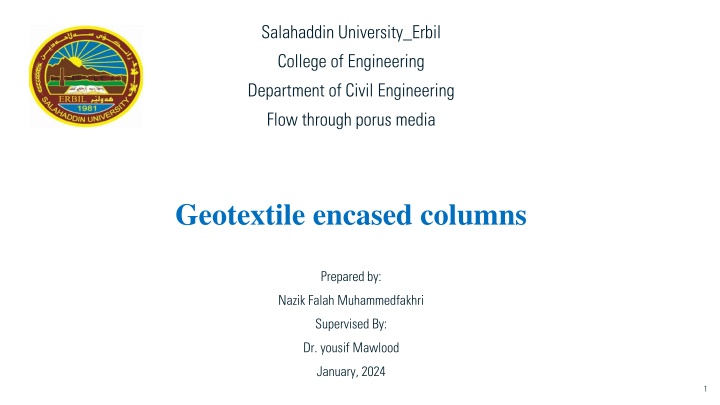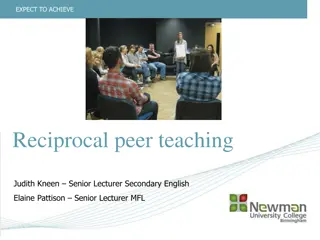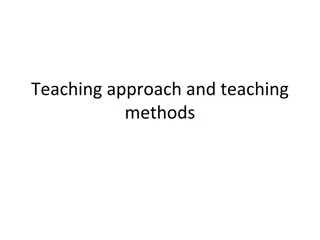
Geotextile Encased Columns in Civil Engineering
Explore the concept of geotextile encased columns (GECs) in civil engineering, their principles, working mechanism, advantages, and applications in stabilizing soft soils. Learn about the construction process, installation steps, and why GECs are utilized in challenging soil conditions.
Download Presentation

Please find below an Image/Link to download the presentation.
The content on the website is provided AS IS for your information and personal use only. It may not be sold, licensed, or shared on other websites without obtaining consent from the author. If you encounter any issues during the download, it is possible that the publisher has removed the file from their server.
You are allowed to download the files provided on this website for personal or commercial use, subject to the condition that they are used lawfully. All files are the property of their respective owners.
The content on the website is provided AS IS for your information and personal use only. It may not be sold, licensed, or shared on other websites without obtaining consent from the author.
E N D
Presentation Transcript
Salahaddin University_Erbil College of Engineering Department of Civil Engineering Flow through porus media Geotextile encased columns Prepared by: Nazik Falah Muhammedfakhri Supervised By: Dr. yousif Mawlood January, 2024 1
OUTLINES OUTLINES Introduction Principles and Working Mechanism Types of Geotextiles Advantage and limitation Conclusion References 2
INTRODUCTION INTRODUCTION GEC (geotextile encased columns) are granular piles, most of the time consisting of sand, encased with a high strength geotextile. The purpose of this geotextile is to ensure the piles integrity and provide confinement in very weak soils. They involve the insertion of columns (commonly stone columns or concrete piles) into soft or loose ground and encasing them with a high-strength geotextile fabric. 3
Why Why we use it we use it The system is used on location where very soft soil exist and a solution with surcharge is not capable to provide the required stability or residual settlement within the given construction period. Applying GEC will result in the following effects: Reduction of residual settlement by 50 75% and can be mitigated by temporary surcharge Up to 90% of the consolidation takes place during construction Able to be used in extremely soft soil (e.g., undrained shear strength < 15 kPa) Loadable immediately after installations 4
Principles and Working Mechanism Principles and Working Mechanism The construction of geotextile encased columns (GECs) involves several steps that aim to improve the ground conditions and provide stability to the soil. the typical construction process for GECs: 1. Site Investigation and Design Site Survey: Initial site investigation to understand soil properties, composition, and engineering characteristics. Geotechnical Analysis: Conducting tests to determine soil parameters, bearing capacity, and other relevant geotechnical properties. Design Stage: Based on the site investigation and analysis, engineers develop a design for the GECs, considering load requirements and soil conditions. 5
2) Installation Preparation Preparation of the Work Area: Clearing the site and preparing the ground for construction equipment and machinery. Layout and Marking: Establishing the grid layout and marking the locations where the columns will be installed. 6
3. Installation of Geotextile Columns Drilling or Vibro-Replacement: Using drilling rigs or vibro-replacement equipment to create boreholes or cavities in the soil where the columns will be placed. Insertion of Geotextile Tubes: Placing or inserting geotextile tubes or columns into the boreholes. These tubes are filled with granular materials like stone, gravel, or sand. Compaction and Installation Depth: Ensuring proper compaction of the granular fill material within the geotextile tubes and reaching the desired depth to reinforce the soil. 7
4. Compaction and Testing Compaction Verification: Verifying and ensuring the proper compaction of the fill material within the geotextile tubes to achieve the desired strength and stability. Load Testing: Conducting load tests to evaluate the performance and bearing capacity of the installed columns. 5. Quality Control and Assurance Monitoring and Inspection: Regular monitoring and inspection during the construction process to verify compliance with design specifications and quality standards. Sample Footer Text Sample Footer Text 9
Types of geotextiles o Geotextile encased stone columns (GEC) Geotextile encased stone columns (GEC) Method: stone or aggregate is inserted and compacted within a geotextile sleeve or casing. Function: these columns enhance soil stability by improving load-bearing capacity and reducing settlement through the vertical columns' reinforcement effect. 10
o Geotextile Encased Cementitious Columns (GCC or Geotextile Encased Cementitious Columns (GCC or Geopiers Geopiers) ) Method: Cementitious material or grout is injected into the ground through a casing formed by geotextile sleeves.These columns create stiff columns or pillars within the soil, reinforcing it and providing additional load-bearing capacity, and provide confinement in very weak soils up to an undrained shear strength of 15kPa. 11
Geotextile encased sand columns Geotextile encased sand columns o Method: granular sand or other fine aggregates are placed within geotextile sleeves. Function: similar to stone columns, these enhance soil stability and load-bearing capacity, particularly in loose or soft soils. 12
o Geotextile Geotextile- -encased prefabricated vertical drains (PVD) encased prefabricated vertical drains (PVD) Prefabricated vertical drains (pvds) or wick drains' are composed of a plastic core encased by a geotextile for the purpose of expediting consolidation of slow draining soils. They are typically coupled with surcharging to expedite preconstruction soil consolidation. 13
Advantage and limitation Advantage and limitation Advantages: Advantages: Improved Soil Stability: Reinforces weak soils, enhancing their load-bearing capacity, and reduces settlement. Versatility: Adaptable for various soil conditions, including loose or soft soils, providing stability in a wide range of situations. Cost-Efficiency: Often more cost-effective compared to traditional deep foundation systems, reducing construction time and materials required. Environmentally Friendly: Generally, installation produces minimal environmental impact compared to other methods. Construction Flexibility: Can be used in restricted access sites or areas with height limitations where other foundation methods might be impractical. Uniform Settlement Control: Assists in reducing differential settlement, ensuring more uniform settlement across the structure. 14
limitation limitation Limited Bearing Capacity: May have limitations in terms of load-bearing capacity, especially in certain soil conditions or when faced with heavy loads. Long-Term Performance: Long-term performance may vary based on the consolidation and behavior of the surrounding soil over time. Design Complexity: Requires a detailed analysis and design process, potentially complicating the construction process. Site-Specific Nature: The effectiveness of geotextile encased columns can be site-specific, requiring careful consideration and analysis before implementation. Quality Control Challenges: Ensuring consistent installation and quality control during construction can be challenging. Maintenance Requirements: Over time, there might be a need for maintenance or monitoring to ensure continued effectiveness. 15
CONCLUSION CONCLUSION The choice of geotextile depends on the specific requirements of the project, including soil conditions, expected loads, drainage requirements, and environmental factors. Each type of geotextile offers different strengths and characteristics suitable for distinct applications in geotechnical engineering. The Common Applications of geotextile encased columns is to Providing filtration and separation in drainage systems, and to Preventing soil erosion on slopes, embankments, or construction sites Used in geotextile encased columns, roadways, and retaining walls for soil stabilization, and to Preventing mixing of dissimilar soil layers in construction projects 16
References: References: 1) Alexiew, D., & Raithel, M. (2015). Geotextile-Encased Columns. B. INDRARATNA, C. JIAN, & R. CHOLACHAT, EMBANKMENTS WITH SPECIAL REFERENCE TO CONSOLIDATION AND OTHER PHYSICAL METHODS, 451-477. 2) Almeida, M. S., Hosseinpour, I., Riccio, M., & Alexiew, D. (2015). Behavior of geotextile- encased granular columns supporting test embankment on soft deposit. Journal of Geotechnical and Geoenvironmental Engineering, 141(3), 04014116. 3) Hosseinpour, I., Almeida, M. S., & Riccio, M. (2016). Ground improvement of soft soil by geotextile-encased columns. Proceedings of the Institution of Civil Engineers-Ground Improvement, 169(4), 297-305. 4) Akosah, S., Chen, J., & Bao, N. (2022). Reinforcement of problematic soils using geotextile encased stone/sand columns. Arabian Journal of Geosciences, 15(16), 1371. 17
THANK YOU THANK YOU 18



















